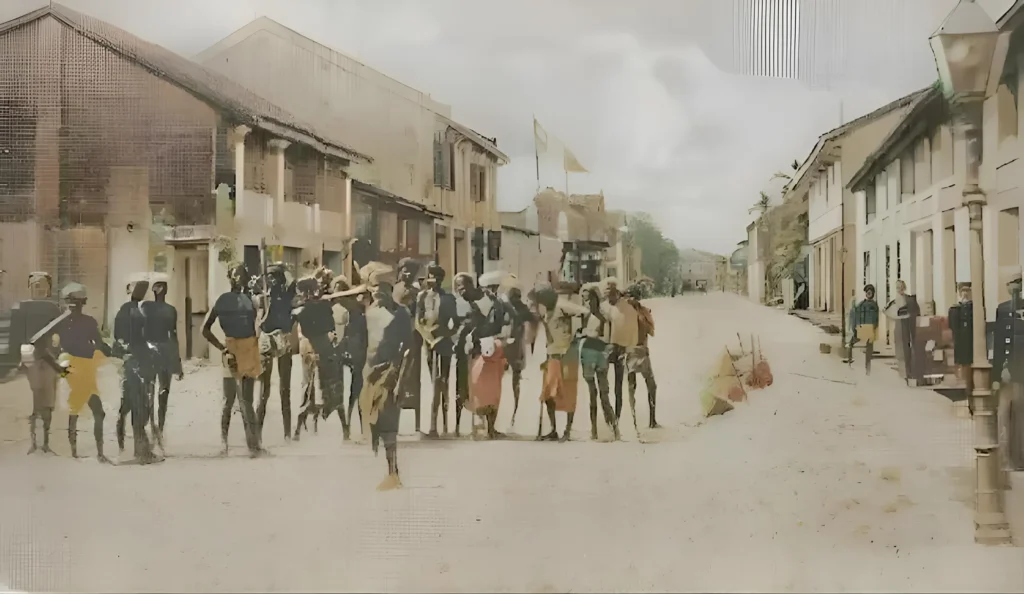“Learn about Malaysia’s evolution from its colonial era to a thriving nation, highlighting the historical events, cultural diversity, and rapid economic growth that have shaped its success..”
A Journey Through History, Diversity, and Economic Growth
Introduction
Malaysia is a vibrant and diverse country located in Southeast Asia, known for its unique blend of cultures, languages, and religions. Comprising 13 states and three federal territories, it is divided into two main regions: Peninsular Malaysia and East Malaysia, which are separated by the South China Sea. The nation boasts a rich history that dates back thousands of years, shaped by various influences from indigenous cultures to colonial powers. With a population exceeding 34 million, Malaysia is recognized as one of the world’s most multi-ethnic countries, where Malay, Chinese, Indian, and numerous indigenous groups coexist harmoniously.
The importance of Malaysia in Southeast Asia cannot be overstated. It serves as a key economic hub within the region, benefiting from its strategic location along the Strait of Malacca—one of the busiest shipping lanes in the world. Malaysia’s economy has transformed significantly over the decades, evolving from an agriculture-based system to a more diversified economy with strong manufacturing and service sectors. Additionally, it plays an active role in regional organizations such as ASEAN (Association of Southeast Asian Nations), promoting cooperation and development among member states.
Historical Background
Early History and Indigenous Cultures
Malaysia’s history dates back approximately 40,000 years, with evidence of early human habitation found in sites like the Niah Caves in Sarawak. The first inhabitants, believed to be the Negritos, were followed by successive waves of migration that brought various ethnic groups to the region. These early communities engaged in hunting, gathering, and later, agriculture. By around 2500 to 1500 BCE, Neolithic cultures had developed, leading to the establishment of small Malay kingdoms by the 2nd or 3rd century CE. The arrival of Indian traders introduced Hinduism and Buddhism, profoundly influencing the local culture and governance structures
Colonial Period and Impact on Malaysia (MALAYA)
The colonial era began in the late 15th century when European powers sought control over the lucrative spice trade. The Portuguese first captured Malacca in 1511, followed by the Dutch and eventually the British in the 18th century. Known as Malaya, the British colonial rule significantly altered Malaysia’s social and economic landscape. The introduction of cash crops like rubber and tin mining transformed the economy but also led to significant social changes, including increased immigration from China and India. This period was marked by exploitation and resistance, culminating in movements for independence as nationalistic sentiments grew among the local population
Malaya’s Path to Independence: A Turning Point in History
Malaya’s journey to independence from British colonial rule culminated on August 31, 1957, marking a significant milestone in the nation’s history. Following World War II, nationalist sentiments surged among the local population, fuelled by discontent with colonial governance and the desire for self-determination. The British, recognising the need for reform, initiated negotiations with various ethnic leaders, including those from the United Malays National Organization (UMNO) and the Malayan Chinese Association (MCA). These discussions led to the establishment of a coalition government that represented the diverse ethnic groups within Malaya.
The culmination of these efforts was the formation of the Federation of Malaya, which granted autonomy while ensuring special rights for Malays. Tunku Abdul Rahman emerged as a prominent leader during this period, advocating for peaceful negotiations and unity among the different communities. His leadership was instrumental in fostering a sense of national identity and purpose. The successful negotiations resulted in Malaya becoming an independent member of the Commonwealth, setting the stage for future developments in the region, including the eventual formation of Malaysia in 1963.
This period not only marked the end of colonial rule but also laid the foundation for Malaysia’s subsequent political and social landscape, highlighting the importance of cooperation among its diverse populations.
Formation of Malaysia in 1963
The formation of Malaysia on September 16, 1963, was a pivotal moment in its history. It united Malaya with Singapore, Sarawak, and Sabah, creating a federation aimed at fostering economic growth and political stability. The merger was motivated by various factors, including economic disparities among regions and the desire for a stronger political entity to counter regional threats. However, tensions soon arose between Singapore and the federal government over issues such as political representation and economic policies
Key Figures and Events Leading to Formation
Key figures in Malaysia’s formation included Tunku Abdul Rahman, who played a crucial role as the first Prime Minister and a driving force behind the merger. The Cobbold Commission was established to gauge public opinion in Sabah and Sarawak regarding joining Malaysia. Following positive feedback, negotiations proceeded with Singapore’s inclusion based on mutual benefits. However, disagreements over governance led to Singapore’s separation from Malaysia in 1965, which reshaped the political landscape of both nations
Singapore separation

Reasons for the Separation in 1965
The separation of Singapore from Malaysia on August 9, 1965, was primarily driven by deep-rooted political and economic differences between the two entities. Initially united under the Federation of Malaysia on September 16, 1963, Singapore’s integration into the federation was fraught with challenges. The ruling parties of both regions—the United Malays National Organisation (UMNO) in Malaysia and the People’s Action Party (PAP) in Singapore—had fundamentally different visions for the country.Tensions escalated over issues such as financial arrangements, political representation, and racial policies. Singapore felt marginalized due to its significant contributions to the federal revenue while receiving limited autonomy. The situation worsened with communal tensions leading to race riots in July and September 1964, exacerbated by political rhetoric from both sides. The inability to reconcile these differences ultimately led Malaysian Prime Minister Tunku Abdul Rahman to propose Singapore’s expulsion from the federation as a means to prevent further violence and instability.
Impact on Both Nations Post-Separation
The separation resulted in significant changes for both Singapore and Malaysia. For Singapore, it marked the beginning of a new chapter as an independent nation. Under the leadership of Prime Minister Lee Kuan Yew, Singapore focused on nation-building, economic development, and establishing a distinct national identity. The government implemented policies aimed at attracting foreign investment and fostering industrial growth, which laid the groundwork for its rapid economic transformation.Conversely, Malaysia faced challenges following Singapore’s departure. The loss of Singapore’s economic contributions and its strategic position in regional trade created immediate economic strains. However, Malaysia continued to develop its other states and focused on strengthening its national identity among its diverse ethnic groups. The separation also prompted Malaysia to reassess its political landscape, leading to increased emphasis on Malay nationalism and policies that favored the Malay majority.In summary, while the separation initially posed challenges for both nations, it ultimately allowed each to pursue independent paths that shaped their respective identities and trajectories in Southeast Asia.
Post-Independence Progress
Economic Development and Industrialization
Following its independence in 1957, Malaysia underwent significant economic transformation, shifting from an agriculture-based economy to one increasingly focused on industrialization and manufacturing. The introduction of the New Economic Policy (NEP) in 1971 aimed to address economic disparities among ethnic groups, particularly between the Bumiputera (Malay) population and non-Malay communities. This policy facilitated affirmative action measures, granting privileges in areas such as education, business licenses, and public sector employment to promote economic equity.
The 1980s marked a period of rapid industrial growth under Prime Minister Mahathir Mohamad, who implemented policies that encouraged foreign investment and the establishment of manufacturing industries. Key initiatives included the development of the Multimedia Super Corridor and major infrastructure projects like the Petronas Towers and North-South Expressway. By diversifying its economy, Malaysia became one of the leading exporters of electronics and palm oil, contributing to sustained economic growth that positioned it as a significant player in Southeast Asia.
Political Evolution and Governance
Malaysia’s political landscape has evolved considerably since independence. Initially dominated by the Barisan Nasional (BN) coalition—led by the United Malays National Organization (UMNO)—the political scene was characterized by a consociational model that aimed to maintain stability among its diverse ethnic groups. This system allowed for power-sharing among various parties representing different communities, which helped mitigate ethnic tensions.However, political dynamics shifted dramatically after the historic 2018 general elections when the Pakatan Harapan coalition ended BN’s 61-year rule. This change was indicative of growing public dissatisfaction with corruption and governance issues. The subsequent political crises led to further fragmentation, with new coalitions emerging, such as Perikatan Nasional. The political environment remains fluid, reflecting ongoing challenges related to ethnic relations, governance, and calls for reform.
Social Changes and Advancements in Education
Post-independence Malaysia has witnessed significant social changes, particularly in education. The government prioritized educational reforms to enhance literacy rates and provide access to quality education for all citizens. The establishment of various educational institutions, including universities and vocational training centers, aimed to equip the workforce with necessary skills for a rapidly industrializing economy.Moreover, policies promoting bilingual education have fostered cultural exchange among different ethnic communities while ensuring that Malay remains the national language. Despite these advancements, challenges persist regarding educational disparities among ethnic groups. Efforts continue to address these inequalities through targeted programs aimed at improving access for underrepresented populations.In summary, Malaysia’s post-independence progress reflects a complex interplay of economic development, political evolution, and social change. These factors have collectively shaped its identity as a diverse nation striving for unity and progress amidst ongoing challenges.
Demographics of Malaysia
Overview of Population Statistics
As of 2024, Malaysia’s population is estimated to be approximately 34.1 million people, reflecting a steady growth rate of about 1.03% annually. The population has increased significantly from around 8.2 million in 1960, showcasing the country’s demographic evolution over the decades. The distribution of the population is uneven, with about 79% residing in Peninsular Malaysia, which constitutes less than 40% of the country’s total land area2. Urbanization has also been notable, with approximately 74.7% of Malaysians living in urban areas as of recent estimates
Major Ethnic Groups
Malaysia is characterized by its rich ethnic diversity, primarily comprising three major groups:

- Bumiputera (69.9%): This category includes ethnic Malays and various indigenous peoples from Peninsular Malaysia, Sabah, and Sarawak. The Bumiputera community holds significant political and economic influence in the country.
- Chinese (22.8%): Historically a vital part of Malaysia’s economy, the Chinese community has contributed significantly to trade and business sectors. Although their proportion has decreased since independence, their absolute numbers have increased.
- Indian (6.6%): The Indian community in Malaysia is diverse, with a majority being Tamil Muslims and Hindus. They play an essential role in various sectors, including agriculture and services.
In addition to these groups, there are numerous indigenous communities known as “Orang Asli” in Peninsular Malaysia and various ethnic groups in East Malaysia, such as the Iban and Kadazan-Dusun, which enrich the cultural tapestry of the nation

Cultural Diversity and Its Significance
The cultural diversity of Malaysia is one of its most defining features, fostering a unique blend of traditions, languages, and religions. This multicultural environment is evident in various aspects of daily life, from festivals to culinary practices. Major religions practiced include Islam (approximately 63.5%), Buddhism (around 19%), and Christianity (about 9%) among others.
The significance of this cultural diversity lies not only in its contribution to a vibrant national identity but also in its role in promoting social cohesion and economic development. The Malaysian government has recognized the importance of maintaining harmony among its diverse communities through policies that promote inclusivity and mutual respect. Events such as Hari Raya Aidilfitri, Chinese New Year, and Deepavali are celebrated nationwide, reflecting the country’s commitment to multiculturalism.
Malaysia’s demographics illustrate a complex interplay of ethnicities that shape its societal structure and cultural identity. This diversity is not only a source of national pride but also a crucial element for fostering unity and progress within the nation.
Economic Landscape of Malaysia
Key Industries and Sectors
Malaysia’s economy is diverse, with several key industries driving growth and contributing significantly to its GDP.


- Oil and Gas: Malaysia has substantial reserves of oil and natural gas, which are vital for energy production and export revenues. The petroleum sector significantly influences the national economy and public finances.
- Manufacturing: The manufacturing sector is a cornerstone of Malaysia’s economy, accounting for approximately 23% of GDP. It includes electronics, automotive, machinery, and textiles. Malaysia is known for its production of electrical appliances and components, making it a vital player in global supply chains.
- Palm Oil: Malaysia is one of the world’s largest producers and exporters of palm oil, which plays a crucial role in the agricultural sector. The palm oil industry has been a significant source of income and employment, contributing to rural development and export earnings.
- Tourism: Tourism is another critical sector, contributing about 15% to GDP in pre-pandemic years. Malaysia attracts millions of visitors annually, drawn by its cultural diversity, natural beauty, and modern attractions. The government has been actively promoting tourism as a means to diversify the economy further.
Current Economic Challenges and Opportunities
Despite its robust economic framework, Malaysia faces several challenges:
- Global Economic Conditions: The Malaysian economy has been affected by external factors such as global inflation, supply chain disruptions, and economic slowdowns in major trading partners like China. In 2023, growth was estimated at 4%, down from 8.7% in 2022 due to weakened exports and reduced external demand
- Income Inequality: While poverty rates have decreased significantly over the past decades, income inequality remains a pressing issue. Regional disparities persist, with rural areas lagging behind urban centers in terms of economic development and access to services.
- Youth Unemployment: The youth unemployment rate stands at approximately 11.7%, highlighting challenges in aligning educational outcomes with labor market needs. Addressing this gap is crucial for sustaining economic growth.
Role in ASEAN and Global Trade
Malaysia plays a pivotal role within the Association of Southeast Asian Nations (ASEAN), contributing to regional stability and economic cooperation. As one of the founding members, Malaysia actively participates in various initiatives aimed at promoting trade liberalisation and integration among member states.
In terms of global trade, Malaysia maintains extensive trade connections with over 90 countries, exporting manufactured goods that account for about 70% of total merchandise exports. The Comprehensive and Progressive Agreement for Trans-Pacific Partnership (CPTPP) ratified by Malaysia further enhances its position in global trade by facilitating access to new markets while requiring domestic reforms to meet international standards.
Overall, Malaysia’s strategic location along key shipping routes enhances its role as a trade hub within Southeast Asia, positioning it well for future growth as it continues to adapt to changing global economic dynamics.




